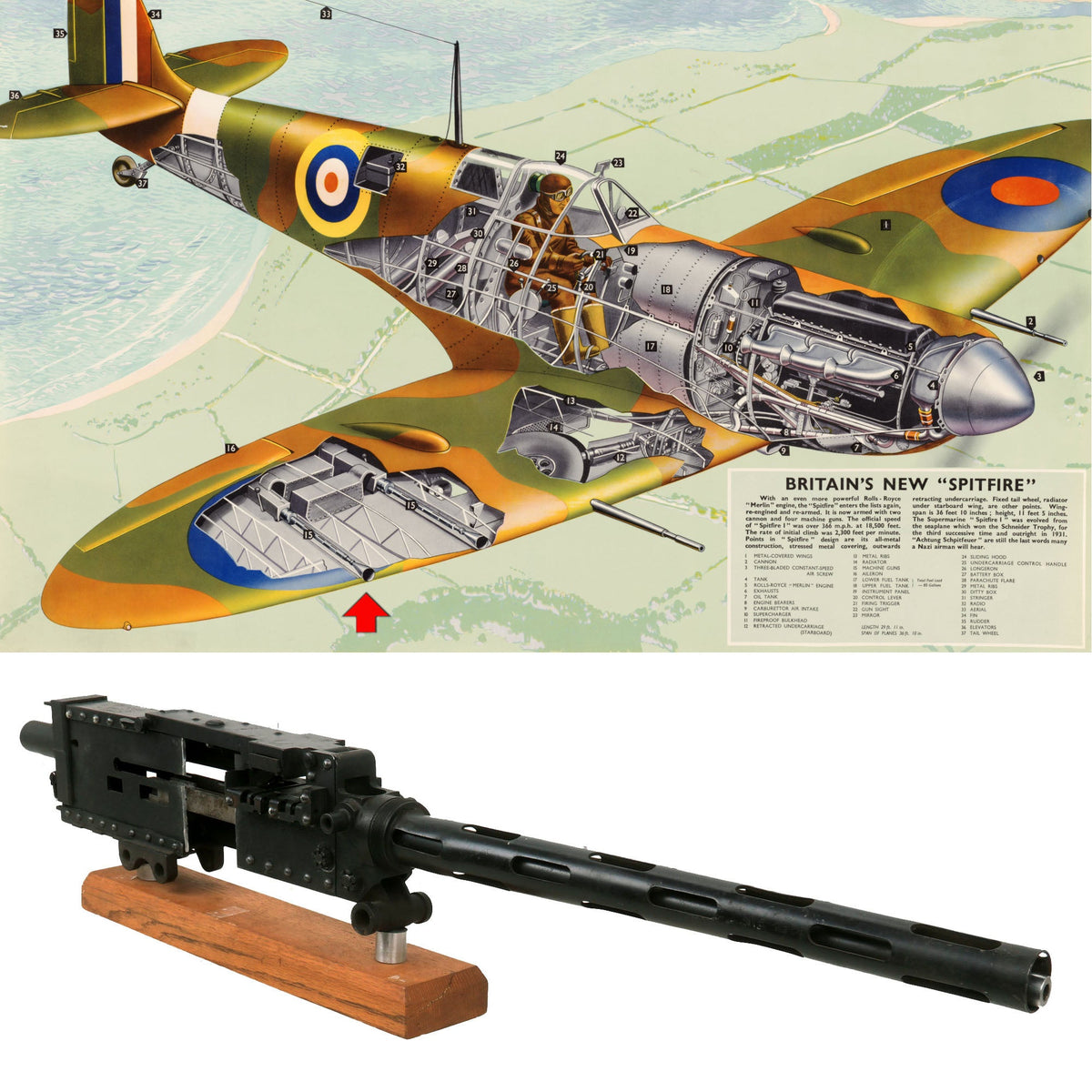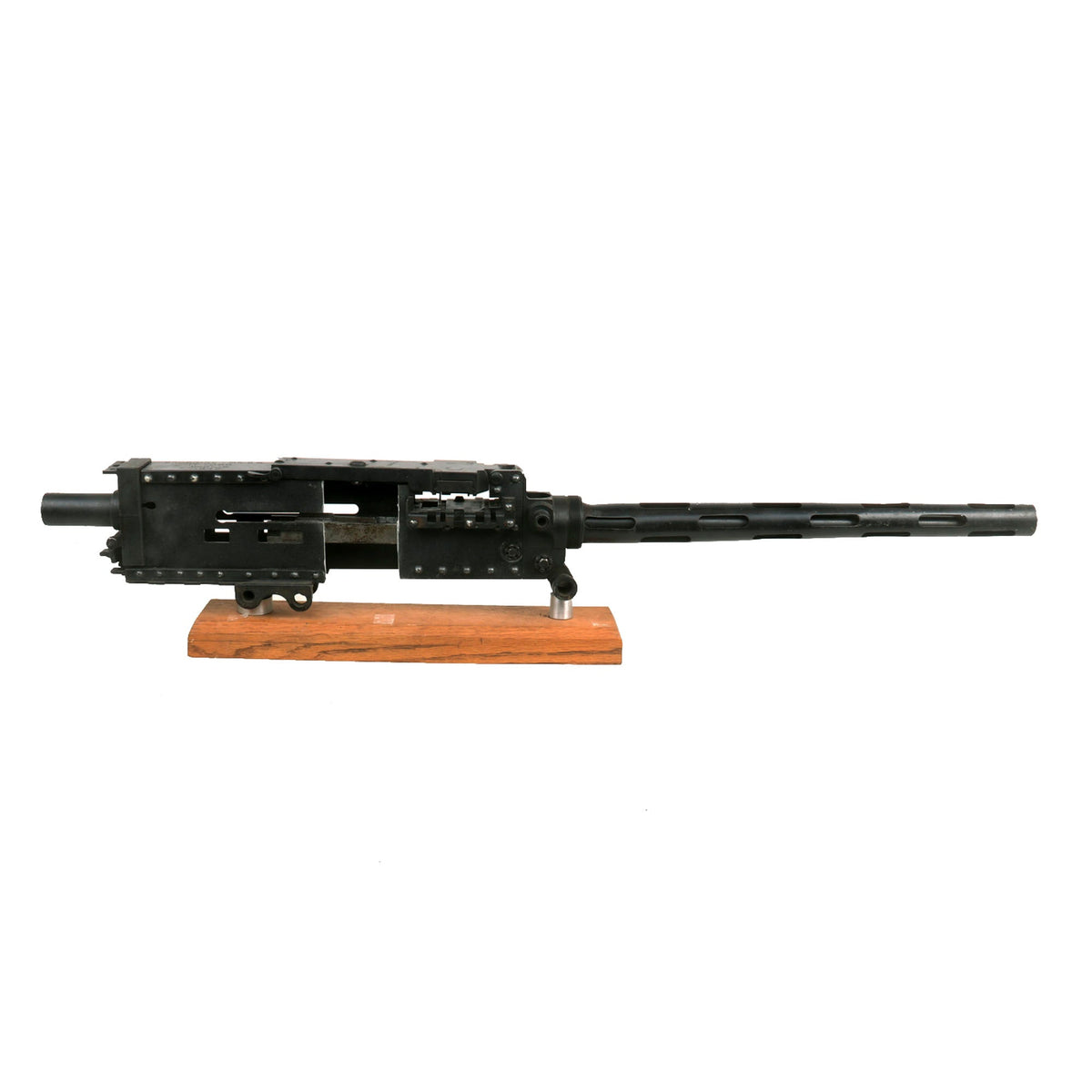Original British WWII 1943 Dated R.A.F. Aircraft Browning .303 Mark II Display Machine Gun by John Inglis on Stand – Spitfire Supermarine, Hawker Hurricane & Avro Lancaster Original Items
$ 4.495,00 $ 1.123,75
Original Item: Only One Available. This is an incredible British WWII Aircraft Browning .303 MkII Display Machine gun, as used in the wings of the Spitfire Supermarine and Hawker Hurricane. These were also used on the Avro Lancaster as hand fired armaments. It is built using all original WWII production components, and has been deactivated to non-firing state following guidelines provided by the ATF, making it a 100% legal display machine gun. The right hand side plate has been completely replaced with a dummy aluminum right side plate, which is totally inert and missing 25% cut out from the center as well. It contains some of the original internal components, now deactivated, which makes this totally legal to own without a license of any kind.
The Browning .303 Mark II was the standard gun used on British aircraft during the 1930s and Second World War. It was adopted by the Royal Air Force (RAF) and manufactured under license by Vickers Armstrong and BSA. The design was based on the 1930 Pattern belt-fed Colt-Browning machine gun with a few minor modifications. The muzzle extension was prone to fouling from the cordite-based ammunition and the RAF redesigned the muzzle extension with chrome plating it to make the surface smoother and cooling fins were also added.
The gun was designed to fire hydraulically as a wing-mounted machine gun on the Supermarine Spitfire and Hawker Hurricane and as hand-fired mount for use in Avro Lancaster bombers and reconnaissance aircraft. It had a rate of fire of 1,150 rounds per minute a muzzle velocity of 2,660 ft/sec. The major advantages were that it was lighter, accurate, and available in large numbers. Near the end of the war, the RAF began adopting .50 caliber machine guns in their bombers.
This example is offered in lovely display condition, and the top cover can still be opened to examine the interior. It is unfortunately missing the muzzle fitting, but that actually makes it a bit more likely that it was a wing mounted example, as they did not have the same type of muzzle fitting / flash hider as when used in the hand fired mounts. The rear top cover still shows the complete maker information:
BROWNING – MK.II ☆
IT 7088
INGLIS
1942
John Inglis was a Canadian company that became very involved in arms production for the war effort. They were especially noted as producers of the Bren Light Machine gun and Browning Hi-Power pistol during WWII. Their JI logo can also be seen on various components of the display gun. The gun is mounted on a lovely block of oak measuring approximately 16″ x 3″ x 1 1/4″.
Overall condition is very good, showing lots of the original finish still present. The only real discrepancy is that at some point the front barrel jacket got bent near the trunion, which is why the barrel is no longer centered. Without the muzzle attachment to support it, the lightweight barrel jacket unfortunately can bend. We did check the barrel, and it has not been deactivated, and actually shows an excellent condition bore.
A fantastic piece of WWII and aviation history, ready to add to your collection!
The Browning Machine Gun was adopted by the Royal Air Force as a replacement for the .303 Vickers machine gun and manufactured by Vickers Armstrong and BSA to fire the British .303 inch (7.7 mm) round and named “Browning .303 Mk II” in British Service. It was essentially the 1930 Pattern belt-fed Colt–Browning machine gun with a few modifications for British use, such as firing from an open bolt to avoid cooking off the cordite rounds and a lighter bolt, increasing the rate of fire, much like the US .30 M2/AN aircraft variant. It was designed to fire hydraulically or pneumatically as a wing mounted machine gun but was also adopted as hand-fired mount for use in bombers and reconnaissance aircraft. It had a rate of fire of 1,150 rounds per minute. The license was issued to BSA by July 1935.
The Browning .303 was used as the RAF and Fleet Air Arm (FAA) primary fixed forward firing aircraft armament before the war, both in synchronized mounts (firing through a spinning propeller) on pre-war biplane fighters (Gloster Gladiator, Hawker Fury) and on the UK’s new ‘eight-gun fighters’ the Hawker Hurricane and Supermarine Spitfire and the naval Fairey Fulmar, and as secondary weapons in mid-war variants of the Spitfire, as well as being fitted in single, double or quadruple mounts as offensive weapons for the Bristol Blenheim, the Fairey Battle, Handley Page Hampden, Martin Maryland/Baltimore, Fairey Swordfish, Lockheed Hudson, Douglas Boston, Blackburn Skua and Bristol Beaufort. It was also used as a turret gun in various Boulton Paul or Nash & Thompson turrets on bombers and flying boats. Even after the introduction of autocannon as primary fighter armament .303 Brownings were retained as supplementary weapons on many aircraft including later versions of the Spitfire, as well as fighter-bomber and night fighter versions of the de Havilland Mosquito, among others.
For hand-held moveable mount use the Vickers K machine gun was preferred. There is pictorial evidence of the .303 Browning being placed on improvised bipods for ground use during the early campaigns in Burma and Malaysia.
Fast Shipping with Professional Packaging
Thanks to our longstanding association with UPS FedEx DHL, and other major international carriers, we are able to provide a range of shipping options. Our warehouse staff is expertly trained and will wrap your products according to our exact and precise specifications. Prior to shipping, your goods will be thoroughly examined and securely secured. We ship to thousands clients each day across multiple countries. This shows how we're dedicated to be the largest retailer on the internet. Warehouses and distribution centres can be located throughout Europe as well as the USA.
Note: Orders with more than one item will be assigned a processing date depending on the item.
Before shipping before shipping, we'll conduct a thorough inspection of the items you have ordered. Today, the majority of orders will be delivered within 48 hours. The delivery time will be between 3-7 days.
Returns
The stock is dynamic and we cannot completely manage it because multiple stakeholders are involved, including our factory and warehouse. So the actual stock may alter at any time. It's possible that you may not receive your order once the order has been made.
Our policy is valid for a period of 30 days. If you don't receive the product within 30 days, we are not able to issue a refund or an exchange.
You can only return an item if it is unused and in the same state as the day you received it. You must have the item in its original packaging.
Related products
Uncategorized
Uncategorized
Uncategorized
Uncategorized
Angolan Rebel 1970s era 60mm Inert Display Mortar from Angolan Civil War Original Items
Uncategorized
Australian WWII Owen MK1 Machine Carbine SMG Custom Fabricated Replica with Sling Original Items
Uncategorized
Uncategorized
Uncategorized
Uncategorized
Uncategorized
Armored Burgonet Helmet & Polearm from Scottish Castle Leith Hall Circa 1700 Original Items
Uncategorized
Uncategorized
Uncategorized
Uncategorized
Uncategorized
Armoured Fighting Vehicles of the World: AFVs of World War One (Hardcover Book) New Made Items












































































